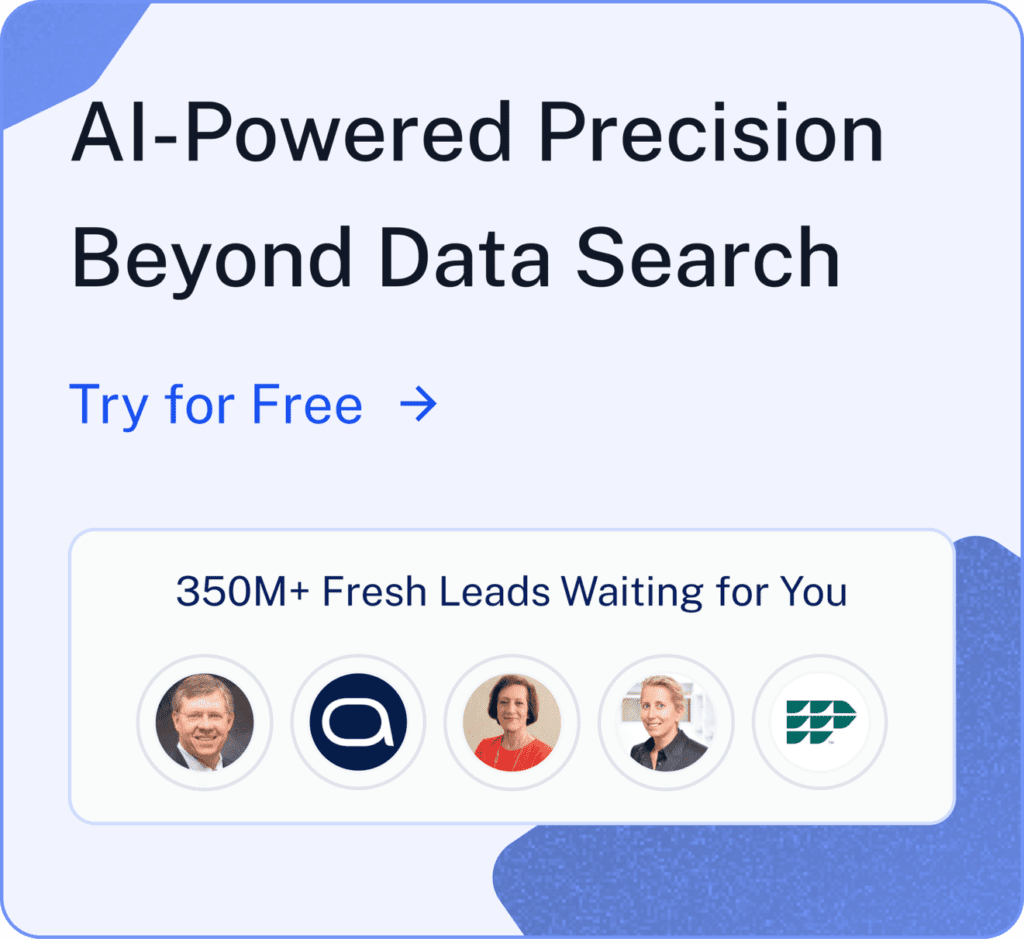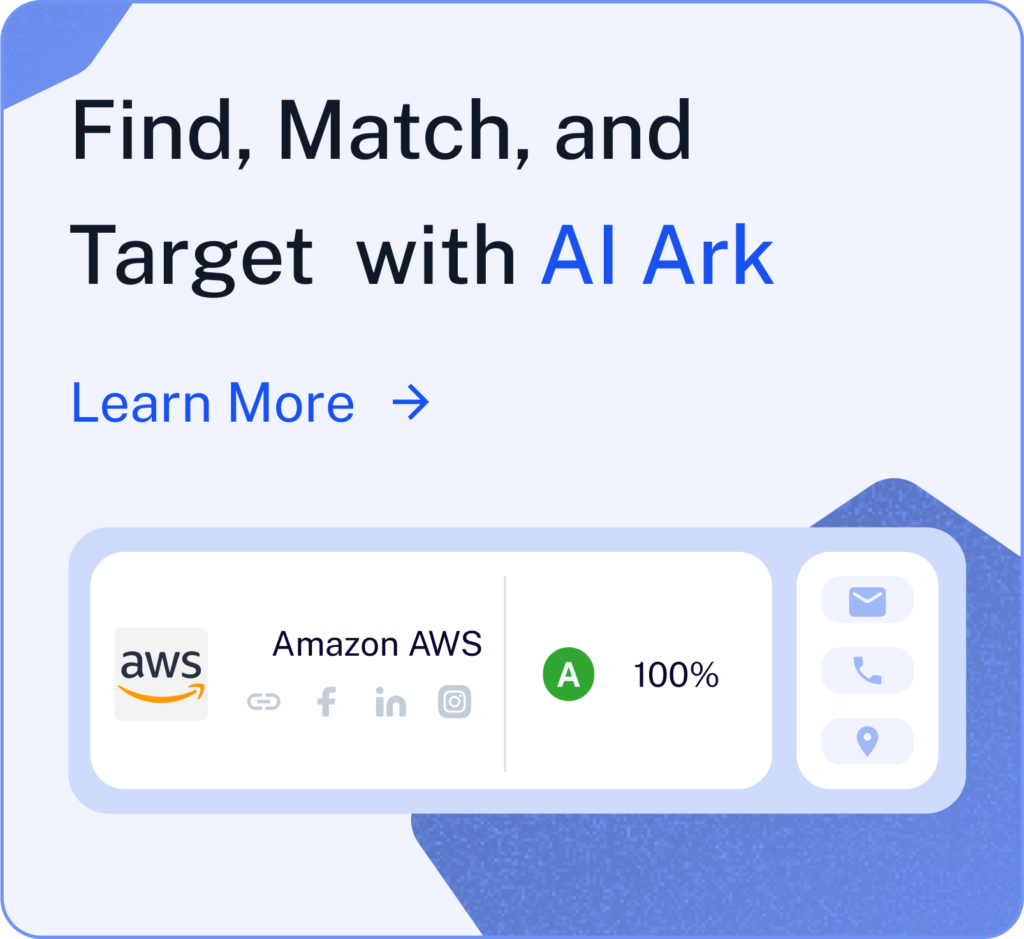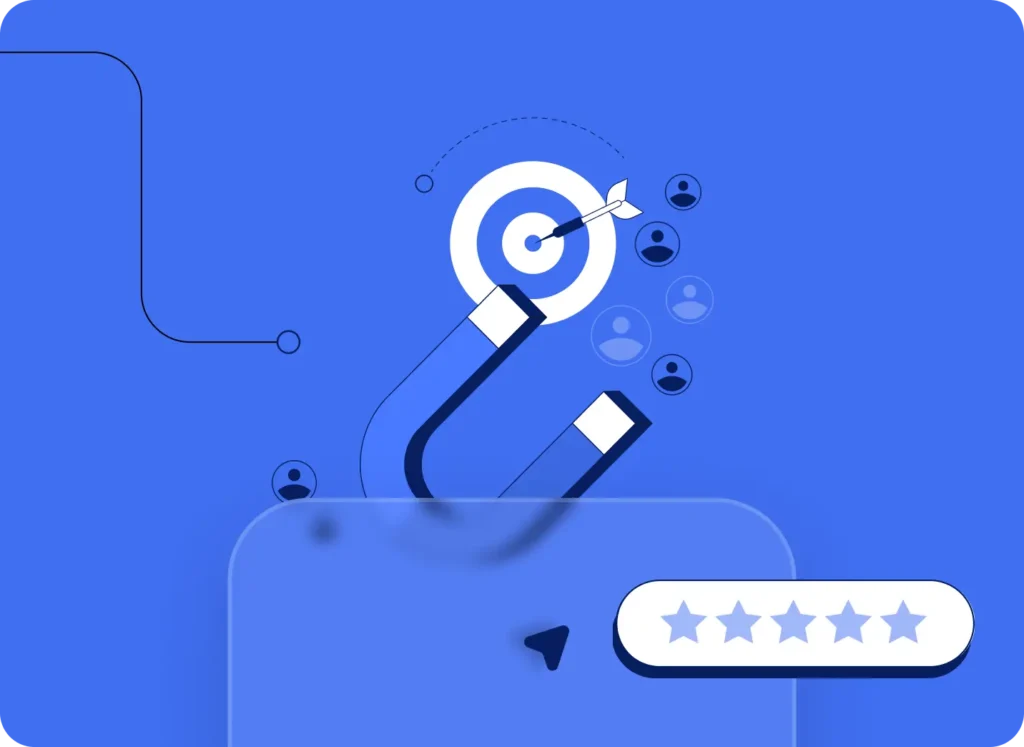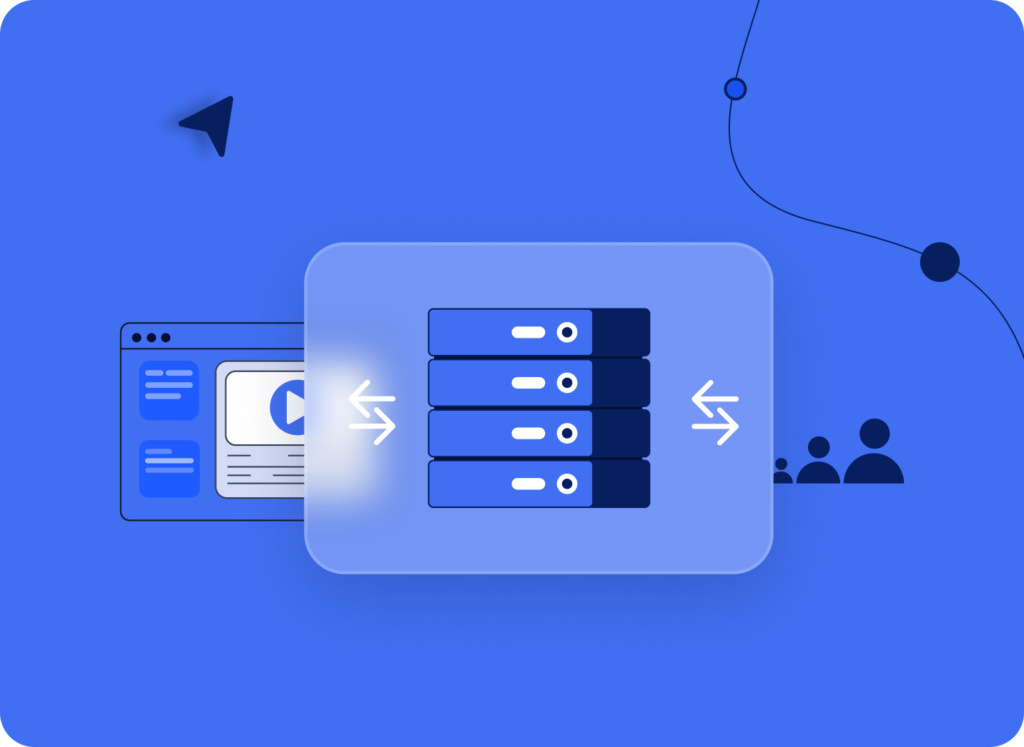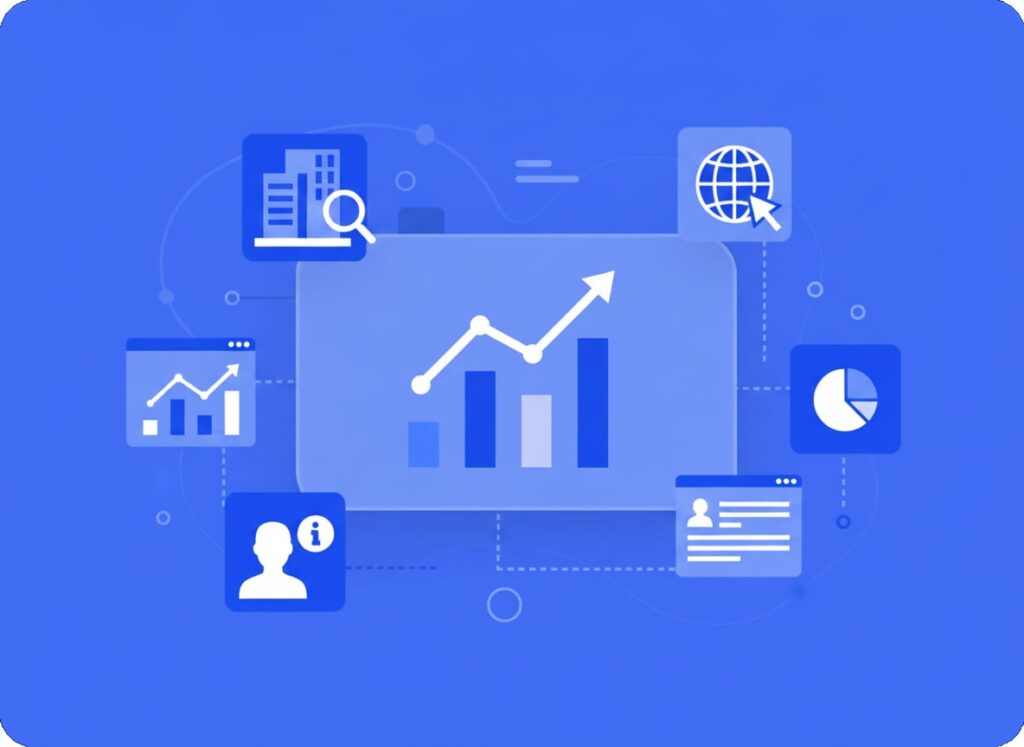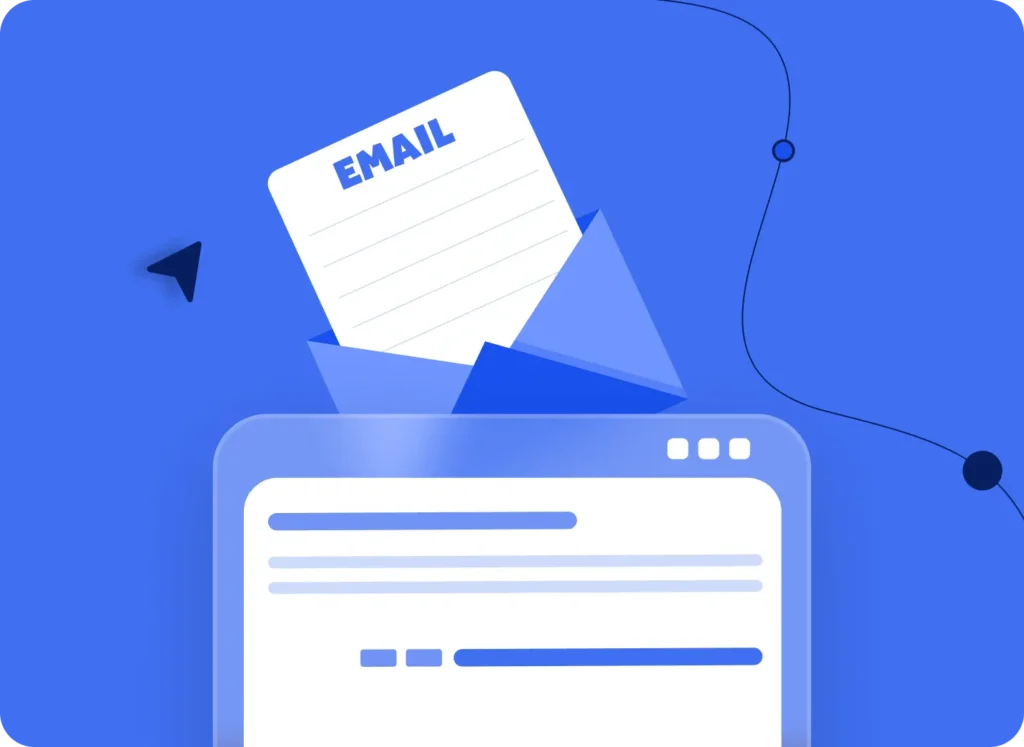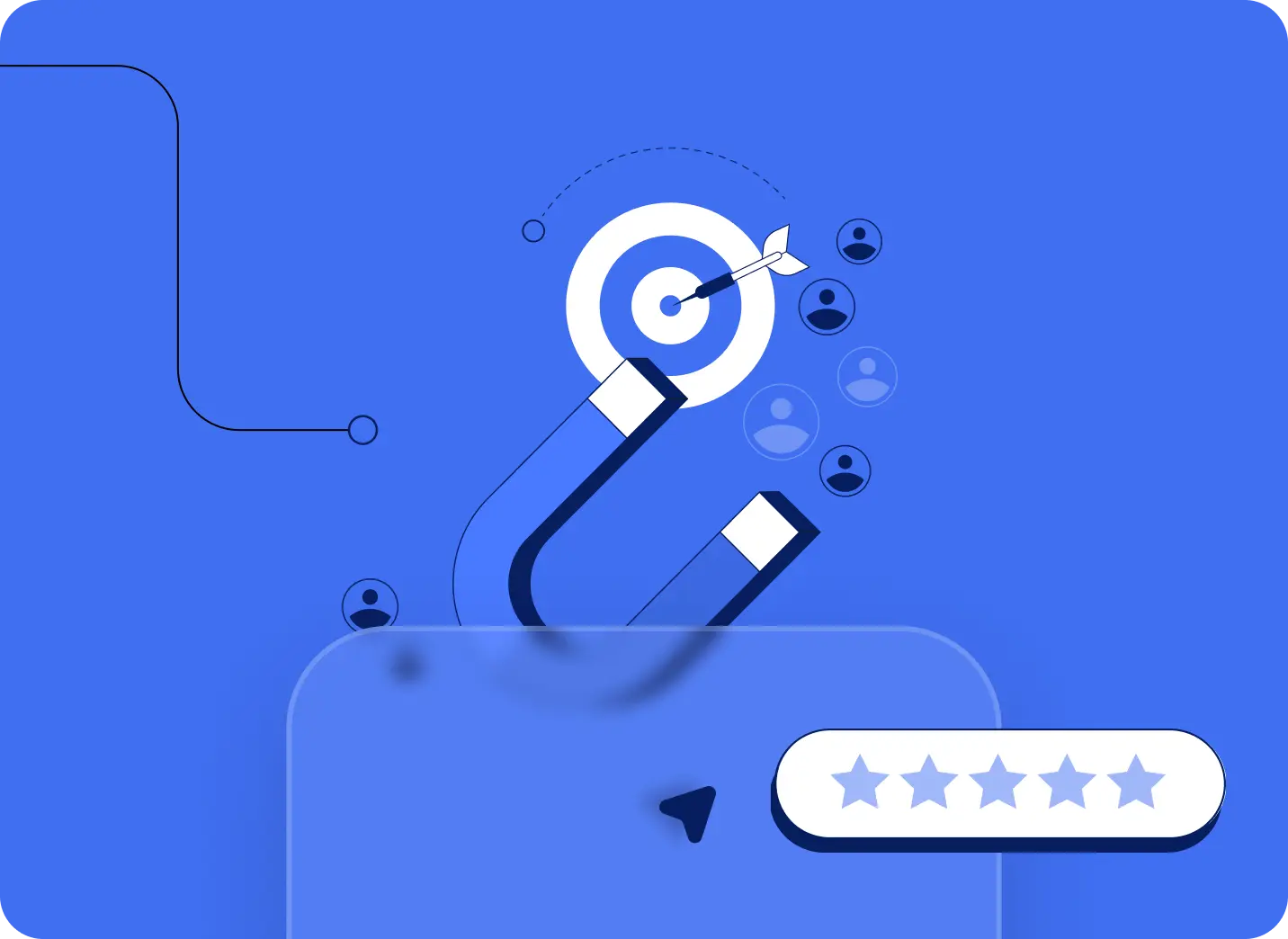Are you tired of browsing a vast database and hoping for the best?
This is where intent-based marketing comes into play. This methodology does the opposite; it targets precisely those customers who have already indicated that they are ready to purchase.
Now, consider combining this approach with the strength of artificial intelligence.
You don’t simply get in front of potential leads; you get in front of the right leads at the right time with the most relevant message.
Regardless of whether you’re developing account-based marketing campaigns, completing your Customer Relationship Management system, or reducing the sales cycle, this blog will clarify what intent-based marketing truly implies in a B2B environment and how AI can accelerate the decoding of intent signals.
Let’s begin.
What Is Intent-Based Marketing?
Intent-based marketing is a targeting approach that focuses on potential leads based on signals that they are ready to buy. Rather than relying on demographics or broad interest categories, it considers behavioral and contextual information to target individuals or companies that are actively searching for a product or solution.
In B2B marketing, intent-based strategies are powerhouses that allow business to identify high-value accounts, accelerate the selling cycle, and utilize resources more effectively.
That said, 70% of B2B companies now leverage intent data to inform their digital marketing engagement directly. This data highlights the importance of intent data, its ability to drive accuracy, and its performance across campaigns.
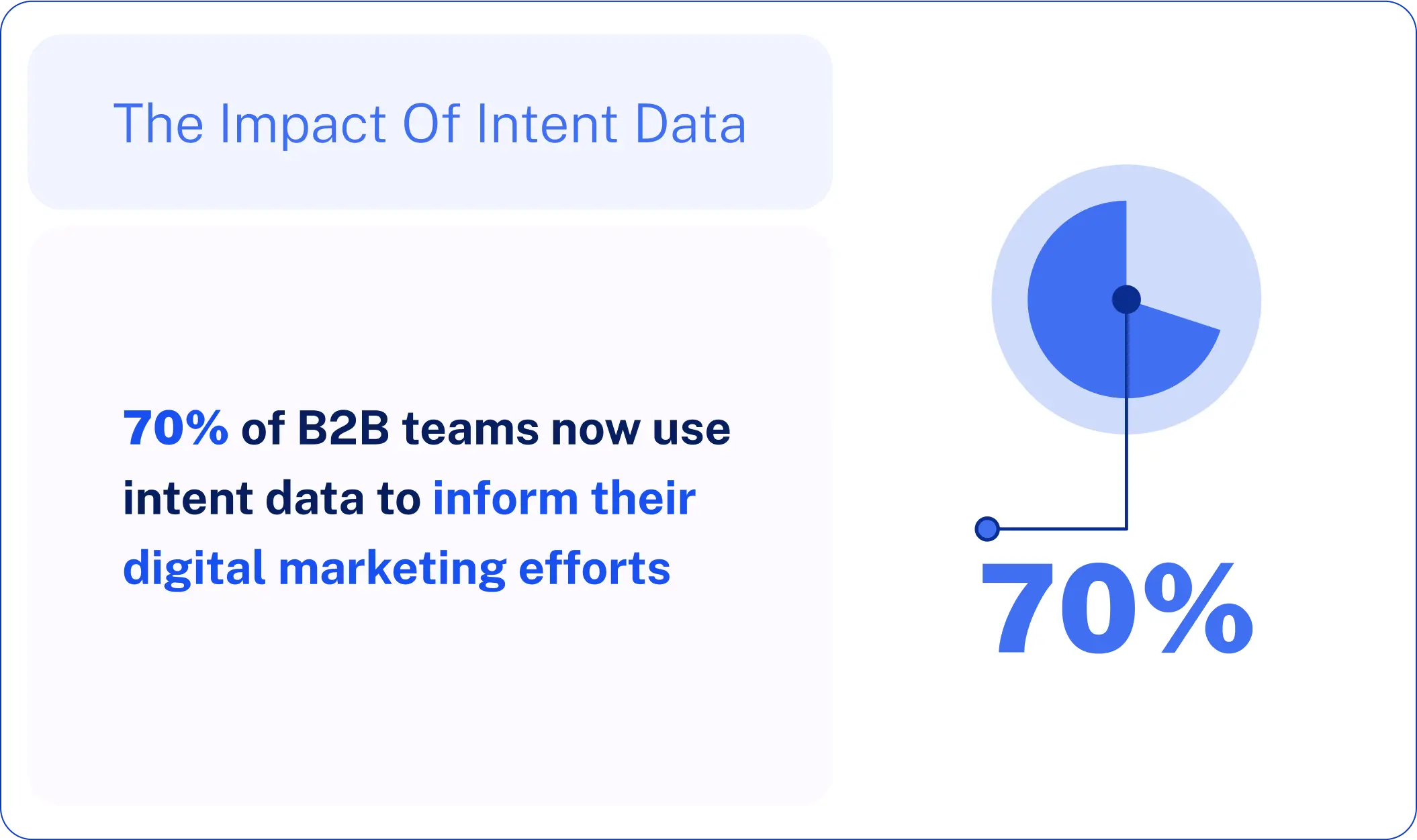
Types of Buyer Intent Signals
When using intent-based marketing, it is crucial to understand the range of intent signals that indicate a person’s position in their buying journey. Here are the main types of intent signals:
Behavioral Signals
Behavioral signals include activities such as multiple visits to a website, prolonged time spent on the product page, reviewing pricing on the website, and reading a white paper. These activities typically represent that a prospect is in an active discovery stage evaluating solutions.
Contextual Signals
Contextual signals are derived from the context where a person is consuming content. This can include reading articles related to specific challenges, speaking in forums about your industry, and researching topics closely related to your offerings.
Firmographic Signals
These pertain to company-level characteristics, including industry, company size, revenue, and location. Together with behavioral data, firmographic signals enable the prioritization of high-value accounts that best fit your ideal customer profile.
Technographic Signals
These reflect the technologies a company currently uses. Understanding a prospect’s tech stack can help tailor outreach to their needs or highlight compatibility with your solution.
By analyzing these signals, either individually or in combination, marketers can identify in-market buyers, personalize their outreach, and increase the efficiency of their lead-generation efforts.
Intent vs interest: What’s the Difference?
While “interest” and “intent” are often used interchangeably in marketing, they describe two very different stages of the buyer journey, and the distinction is worth knowing for effective targeting.
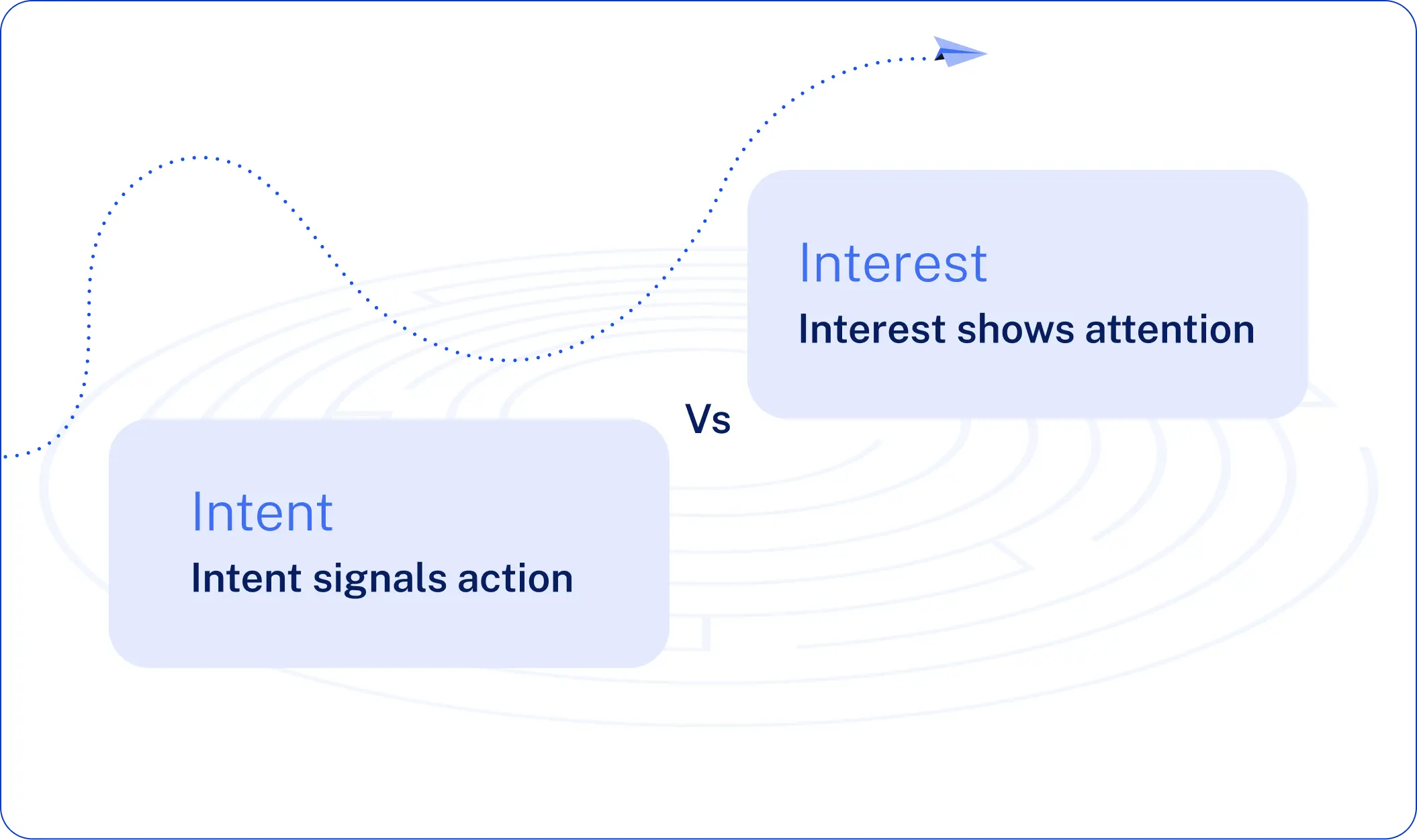
Interest: Is basic curiosity or passive involvement. A prospective customer might read a blog post, view a video, or follow industry trends without currently being interested in making a purchase. Activity shows they are aware but not acting.
Intent: On the other hand, represents a higher level of attention. It indicates deliberate actions that suggest the prospect is preparing to buy or attempting to buy. They are researching product comparisons, going to pricing pages, or requesting demos.
Interest shows attention. Intent shows action.
Intent-based marketing targets these deeper signals, enabling marketers to reach prospects when they’re closer to making a decision, which results in increased conversion potential and a more efficient use of resources.
Why does intent-based marketing matter in B2B lead generation?
B2B marketing success depends on getting in front of the right decision-makers at the right time when they’re considering a solution. That’s where being aware of how to use intent data is a key strength.
Intent-based marketing enables companies to identify and focus on high-intent leads that are already showing interest in comparable products or services. By analyzing intent indicators such as content consumption, keyword research, and site visits, marketers are able to see in real-time which accounts are most likely to convert.
Understanding how to use intent data effectively helps B2B teams to:
- Focus resources on high-potential leads
- Deliver more relevant, personalized communications
- Increase marketing and sales alignment
- Accelerate the buying process through better timing
For B2B companies that require better efficiency and outcomes, leveraging intent-based marketing through smart use of intent data is no longer an option but a requirement. According to a study, 53% of B2B marketers already utilize intent data for lead generation, making it a key point of differentiation in marketing today.
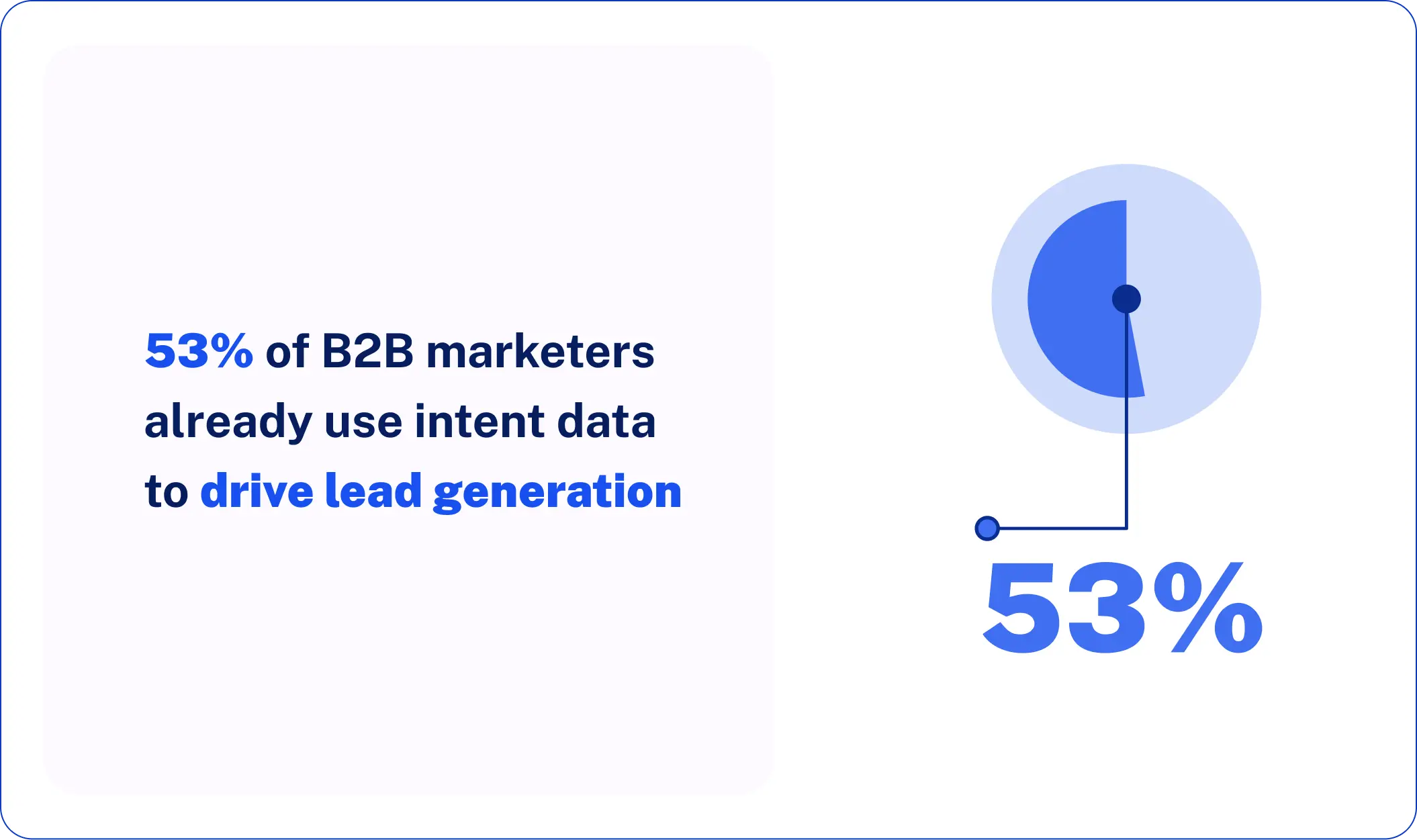
The Role of AI in Intent-Based Marketing
As buyer size and depth grow, artificial intelligence (AI) has become essential in order to make intent-based marketing scalable, timely, and effective. AI not only performs analysis across large datasets but, for the first time, identifies patterns and intent signals that would be impossible for humans to spot by hand.
Benefits of Using AI in Intent-Based Marketing:
- Real-Time Insights: Continuous process of high data volume to provide actionable leads in the market as they are being created.
- Higher Accuracy: Eliminates guessing by identifying those high-conversion intent signals.
- Scalability: Allows marketing and sales groups to process more campaigns and leads without losing relevance.
- Stronger Personalization: Provides highly relevant messages based on behavioral trends and context relevant.
- Faster Decision-Making: Automating evaluation and rank order leads, accelerating the sales cycle.
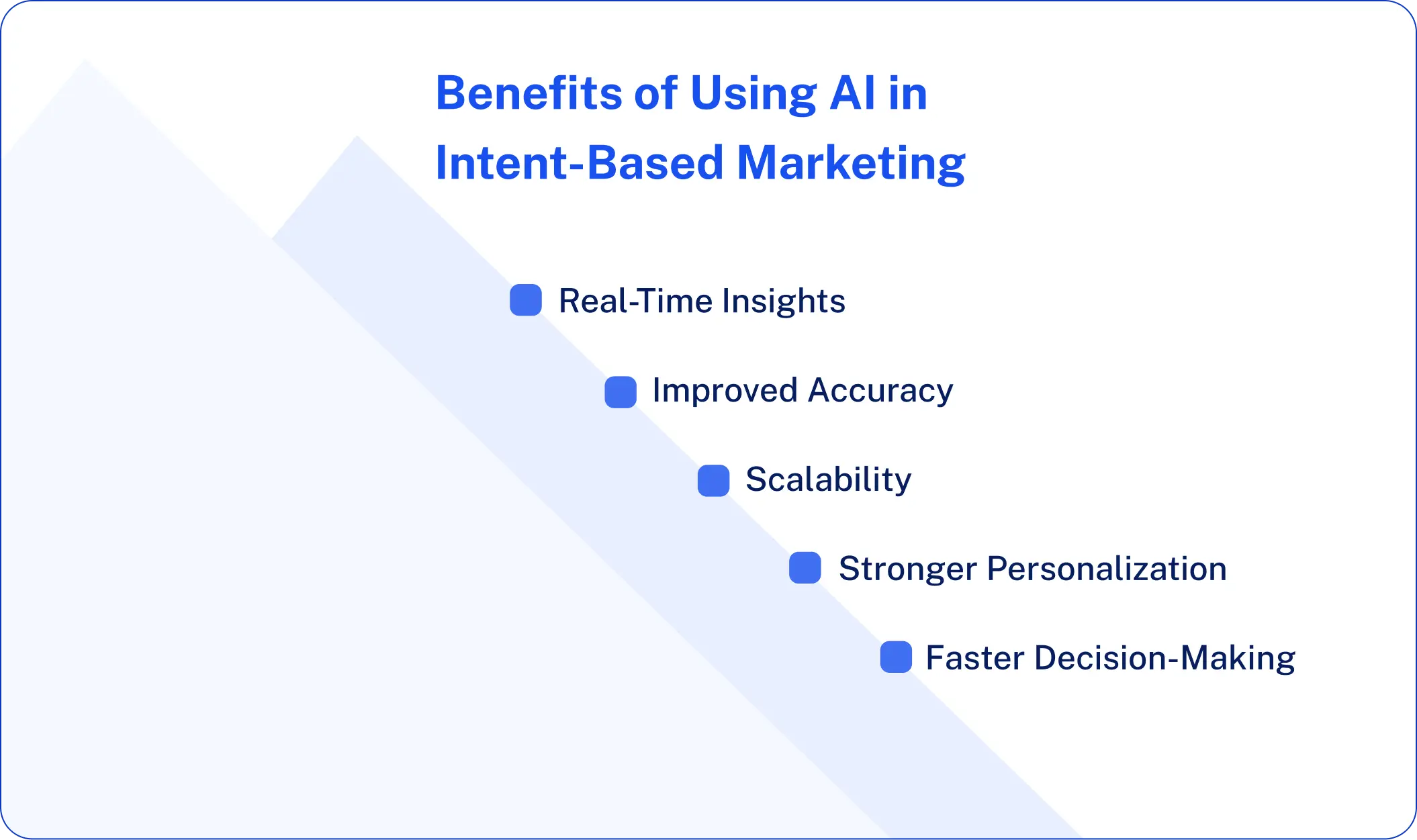
By integrating AI in intent-based marketing procedures, B2B teams realize significant benefits in detecting, qualifying, and engaging the right buyers faster and more effectively than ever before.
How AI Powers Intent-Based Lead Generation
Intent-based lead generation focuses on discovering and engaging prospects who are actively exhibiting buying intent through their web behavior and research patterns. B2B marketing includes searching beyond stale lists and connecting with those in the market for a solution today.
Artificial intelligence is accelerating this process by analyzing vast numbers of intent signals at scale, detecting patterns that indicate readiness to buy, and enabling real-time response to these signals. Today’s B2B intent data providers play the key role in delivering rich behavioral and contextual data, which can be processed and learned by AI models in order to rank the right leads and guide more targeted attention.
Some of the key methods through which AI fuels intent-led lead generation are:
- Processing Large Volumes of Intent Data
Intent data indicators in B2B marketing are derived from multiple sources, including website analytics, third-party publisher networks, CRM activity, and ad platforms. AI is specifically equipped to deal with these huge and dispersed datasets.
By always viewing this data, AI enables marketers to observe when a lead is considering a solution seriously and is about to act.
- Uncovering Patterns and Predicting Intent
Among the several advantages that AI offers, perhaps of greatest value, is its ability to find hidden patterns in buyer behavior. Where human analysts may apply strict scoring models or simple thresholds, AI can analyze intricate combinations of behaviors over time. For example:
- Which order of content interactions signals high intent
- Which group of search terms translates to a buying decision
- How different buyer personas engage along the way
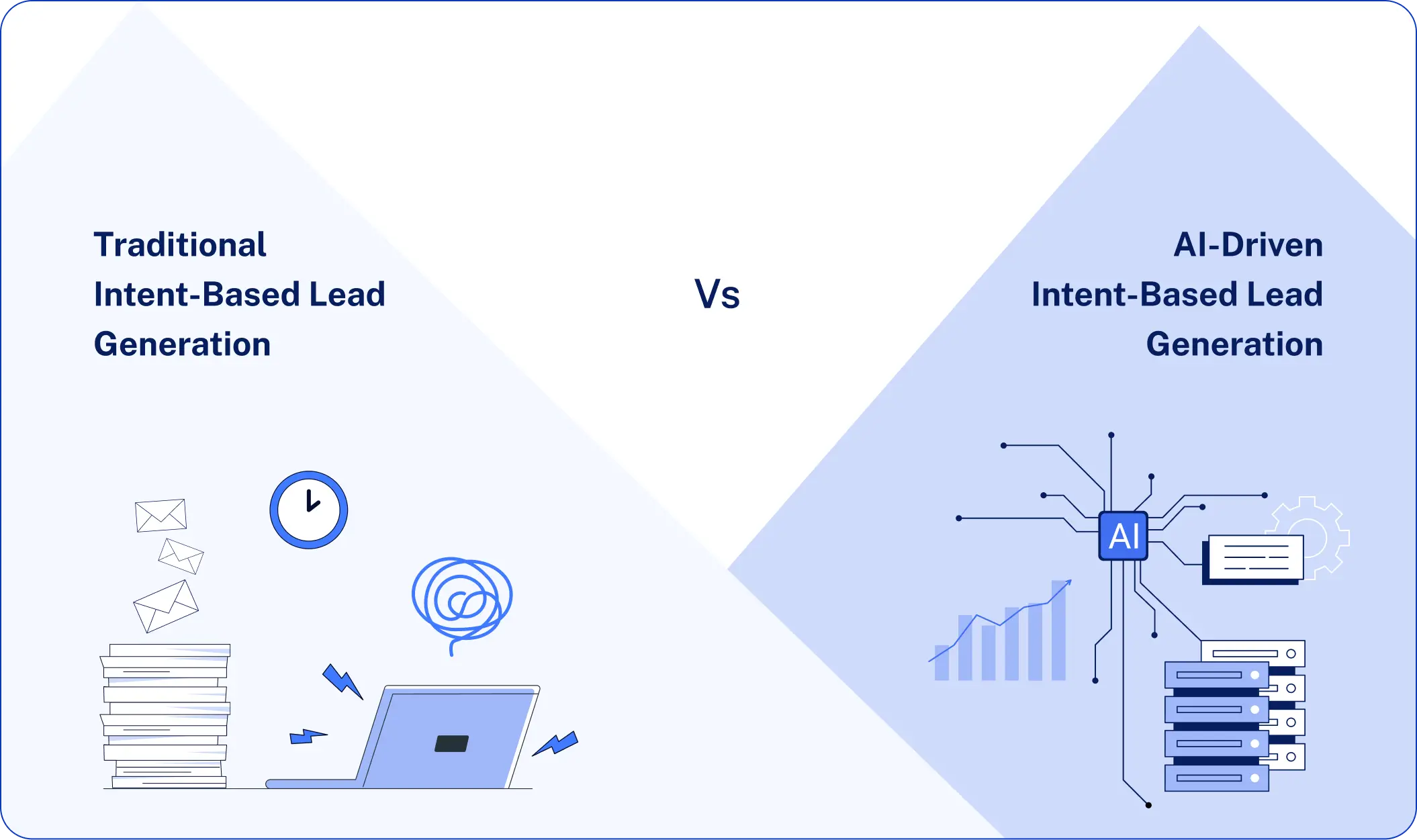
AI uses these patterns to predict which leads are most likely to convert and allows marketers to target the right accounts at the right moment.
- Improving Targeting and Personalization
The quality of targets is enhanced with AI, and there is greater personalization. Targets have in the past been treated as a collective, while AI models will track all prospects’ signs of intent and engagement and personalize the experience for every prospect.
For example:
- Ad platforms can change targeting based on the recent topics a buyer has been researching.
- Website personalization tools can tailor content based on the inferred buyer journey stage.
- Email campaigns can provide different offers based on exact behaviors and interests found.
By moving beyond straightforward demographic segmentation to intent-based personalization, AI enables marketing teams to target prospects with more relevant messaging, thereby improving response rates and conversions.
- Enabling Real-Time Action
Speed matters with intent-based lead generation. The faster your team can act on a prospect’s intent signal, the sooner you’ll have an opportunity to connect with them before others do.
AI enables real-time workflows such as:
- Alerting sales automatically whenever a high-priority account demonstrates strong intent.
- Triggering personalized email outreach as soon as key behaviors are observed.
- Dynamically optimizing ad bids based on intent strength.
- Alerting on accounts that were previously inactive but are now showing new buying signals.
B2B marketers use real-time action to capitalize on moments of high intent when prospects are most likely and ready to convert.
AI helps B2B marketers transform raw signals of intent into actionable insights specific to the individual or account, triggered at the most opportune moment. As more evolved tools currently reach the market, AI-driven intent-based lead generation will continue to be a differentiating factor for marketing teams today.
How to Implement AI for Intent-Based Marketing
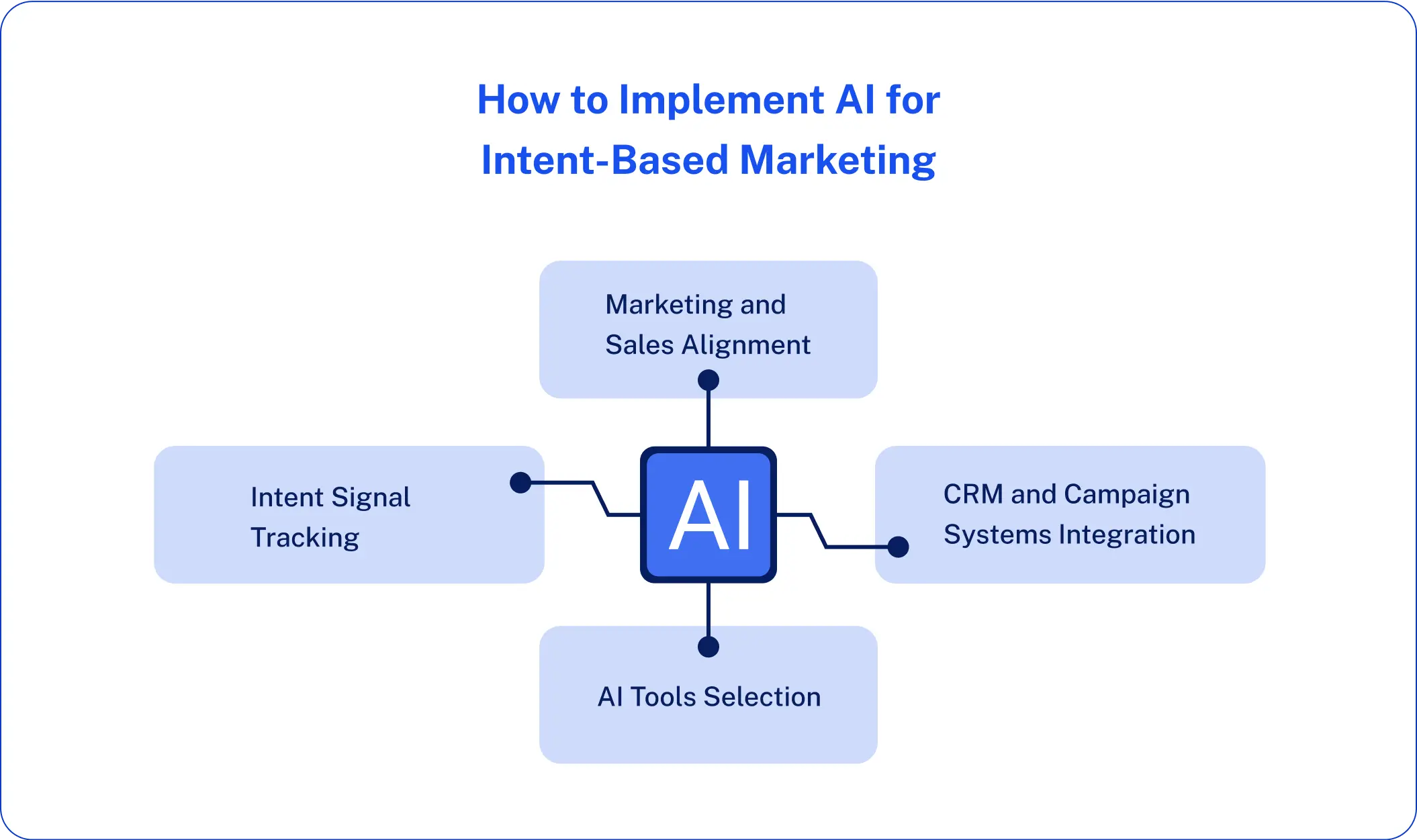
With AI in your intent-based marketing workflow, it’s not technology adoption in vain but about having a solid data foundation, selecting the right tools, deploying them in your processes, and empowering marketing and sales teams to act intelligently on insights.
Below is a step-by-step process that you can customize:
1. Set Up Intent Signal Tracking
You need a consistent pipeline of high-quality intent data before AI can start delivering value.
Start by collecting and pooling signals from numerous various sources:
- First-party data
Data that you collect directly from your own media, such as website traffic, content downloads, email open and click, webinar sign-ups, product page views, and CRM activity. AI can examine this data and discover unique patterns of purchasing among your audience. - Second-party data
Publishers’ or partners’ information that you are collaborating with—like anonymized readership information or engagement metrics for a trade publication.
This increases your understanding of buying behavior beyond your own platforms. - Third-party data
Intent signals from third-party B2B intent data providers—who monitor content consumption, search, and engagement across thousands of online destinations. This allows you to learn about accounts with buying intent before they show up on your site.
AI models perform optimally when they are trained on a wide range of signals; therefore, having a strong data foundation is crucial.
2. Select the Right AI Tools
Select the appropriate AI tools based on your marketing goals and budget. We have outlined the most common types of AI tools that are used for intent-based marketing:
- Intent Data Platforms
Collect first-party and third-party intent data with insights on buying behavior. Often offer dashboards to help you score opportunities and prioritize accounts based on intent trends. - AI-Powered Lead Scoring
Automated tools for scoring leads on intent signals and other characteristics like firmographics, engagement history, etc. Lead scores are updated in real-time as new information is gathered.
- Predictive Analytics Platforms
Use machine learning to forecast which contacts or accounts are most likely to convert. Help marketing and sales teams prioritize outreach by chances to buy.
- AI-Powered Personalization Engines
Personalize website content, email messaging, and ad creative in real time based on intent signals and behavioral data, delivering a more relevant experience to each prospect.
When looking at tools, look for a tool with good data integration, especially with your CRM and marketing automation solutions. Watch for explicit scoring and modeling so your teams can understand how AI is making decisions. Look for tools that process in real-time so you can act on new intent signals.
3. Integrate with CRM and Campaign Systems
For AI insights to drive action, they must be visible and actionable in your marketing and sales systems
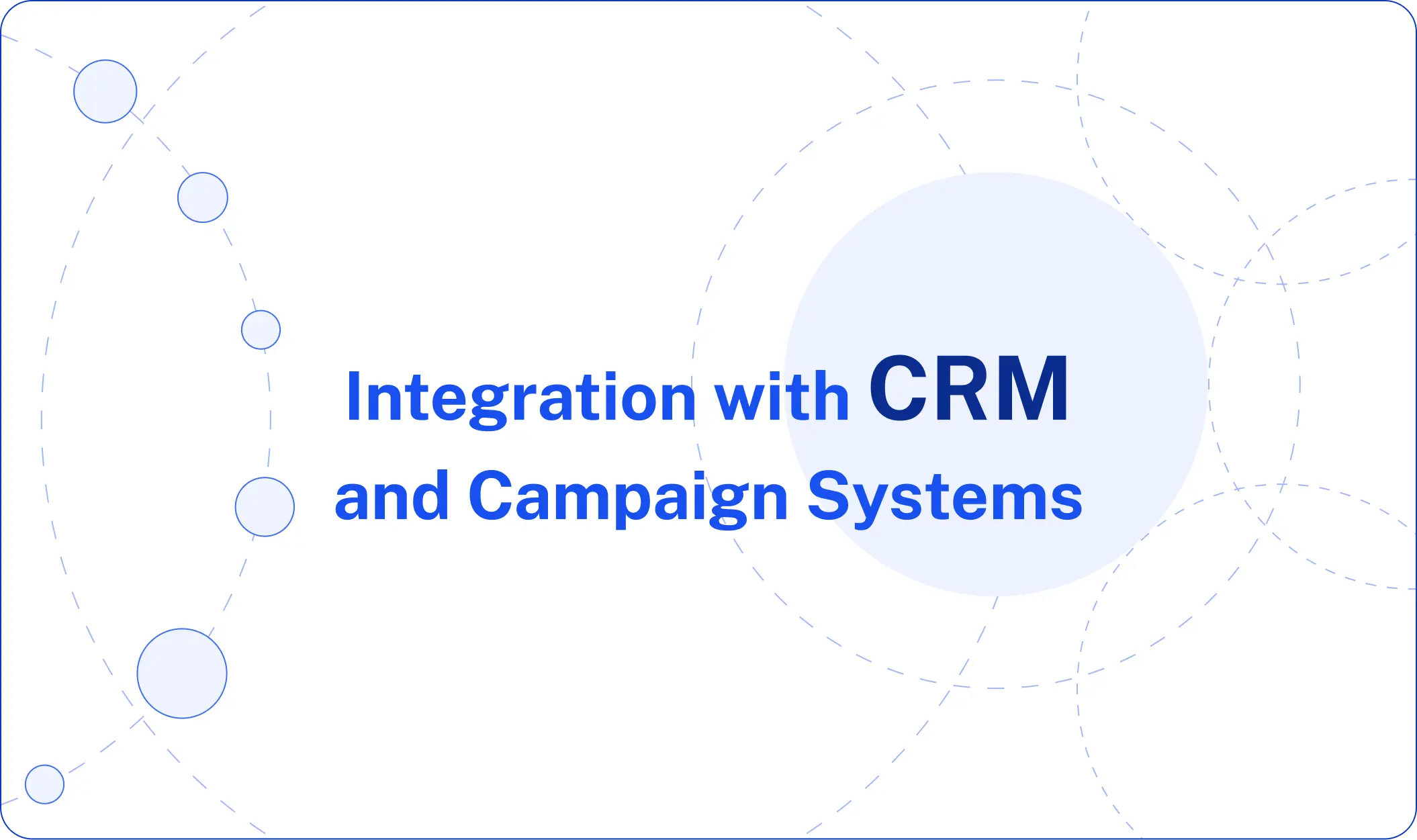
To make that happen, you can highlight:
- CRM integration: Push AI-driven lead scores, intent signals, and account activity into your CRM, so that your sales teams know which leads to work on.
- Marketing automation integration: Set up workflows to automatically send personalized emails, retargeting ads, or sales alerts based on AI-driven intent.
- Real-time alerts: Trigger sales notifications as high-intent activities occur, such as a prospect returning to your price page or a target account viewing late-stage content.
- Reporting dashboards: Provide marketing and sales teams insight into how AI-driven intent signals are influencing pipeline progression and conversion rates.
The goal here is to automatically and systematically drive insights into action.
4. Align Marketing and Sales Around AI-Driven Insights
Without alignment between sales and marketing, even the most sophisticated AI system will not deliver maximum value.
You can begin with aligning following areas:
- Shared definition of high-intent leads: Both teams need to have agreement about what is a high-intent lead and when to pass it on to sales.
- Clear workflows: Specify how marketing will bring to light AI-discovered leads and how sales will follow up on them.
- Feedback loops: Sales must feed back lead quality and outcomes to sales, so marketing is able to refine AI models and lead scoring rules over time.
- Joint measurement: Both must monitor how AI-driven intent data influences key metrics like conversion rates, deal velocity, and pipeline health.
When both sales and marketing are operating from the same playbook driven by AI-powered insights, intent-based marketing is a much stronger revenue driver.
By applying these steps, B2B marketers can move from basic intent data collection to a fully AI-fueled lead generation process, one which discovers and engages high-intent buyers at velocity, precision, and relevance.
Common Mistakes to Avoid in Intent-Based Marketing
In employing intent-based marketing, the majority of organizations make avoidable mistakes that derail the efficiency of their efforts. For the best outcomes, beware of committing any of the following mistakes:
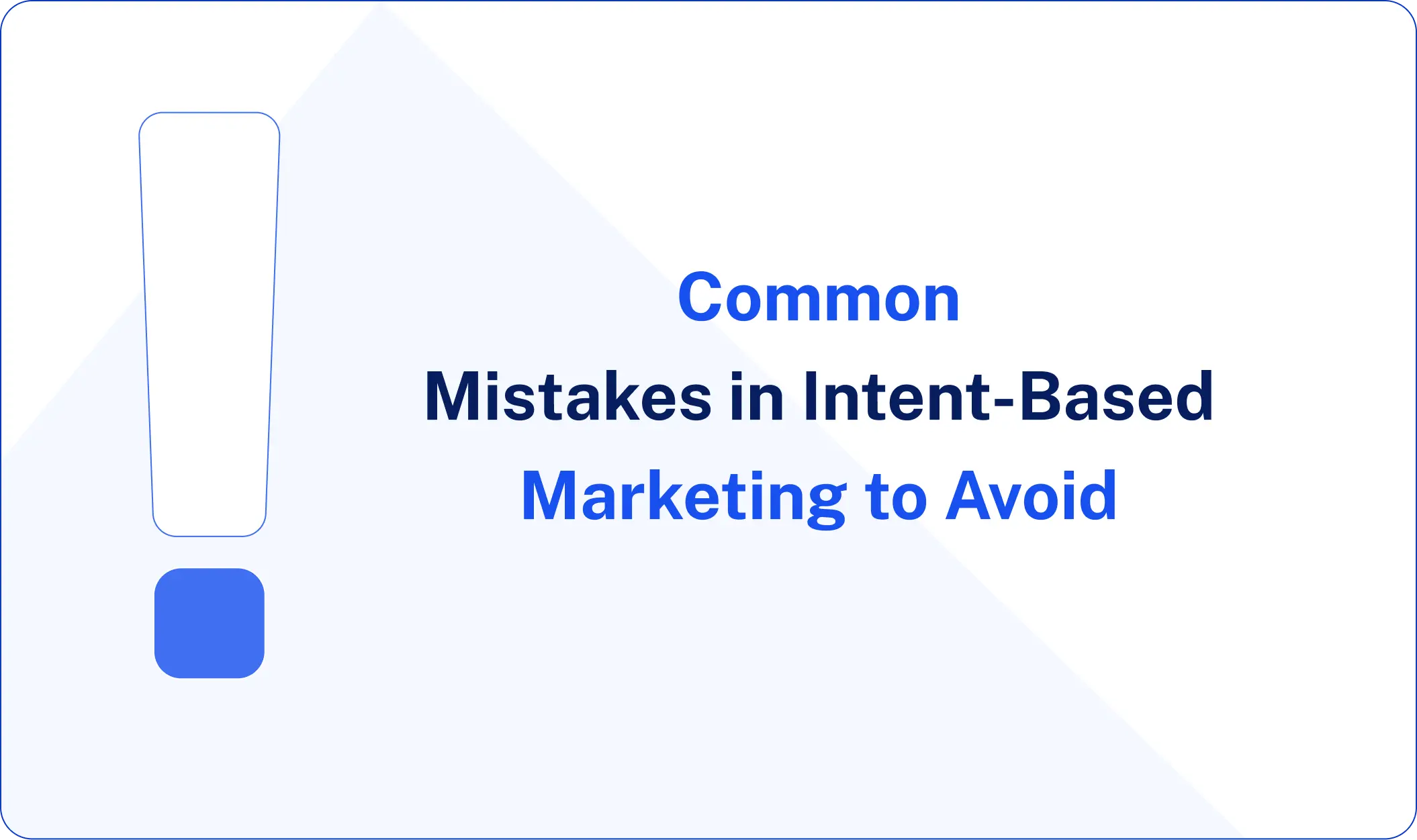
- Relying on a Single Source of Intent Data
Overreliance on a single source of intent data is one of the most prevalent mistakes. Most businesses focus on first-party data or leverage only one third-party intent data provider, for example.
The problem with this approach is that intent signals from any one source are always incomplete. Buyers conduct their research on multiple channels and sites, content portals, review websites, and search engines. The most powerful AI models learn from a broad range of signals, building a much fuller and more accurate picture of buyer intent.
- Treating All Intent Signals as Equal
Not every intent signal indicates the same level of buy readiness. Some companies make the mistake of taking any signal, such as reading a blog post or downloading a generic report, as an indication of strong intent. This leads to misdirected sales efforts.
AI models must be trained to distinguish between early-stage intent behavior and late-stage buying intent signals, such as visiting a pricing page or comparing solutions. Context and sequence of intent signals are the key to ranking the right leads at the right time.
- Using Static Lead Scoring Models
The majority of marketing organizations still rely on static lead scoring models, where predetermined actions are assigned pre-set point values, e.g., five points for signing up for a webinar or ten points for asking for a demo. This can provide basic prioritization but does not capture the dynamic and complex reality of modern buyer behavior.
AI-driven lead scoring models analyze patterns across numerous dimensions and update scores as new intent signals are produced. This offers sales and marketing teams a constantly up-to-date and accurate picture of a prospect’s potential to convert.
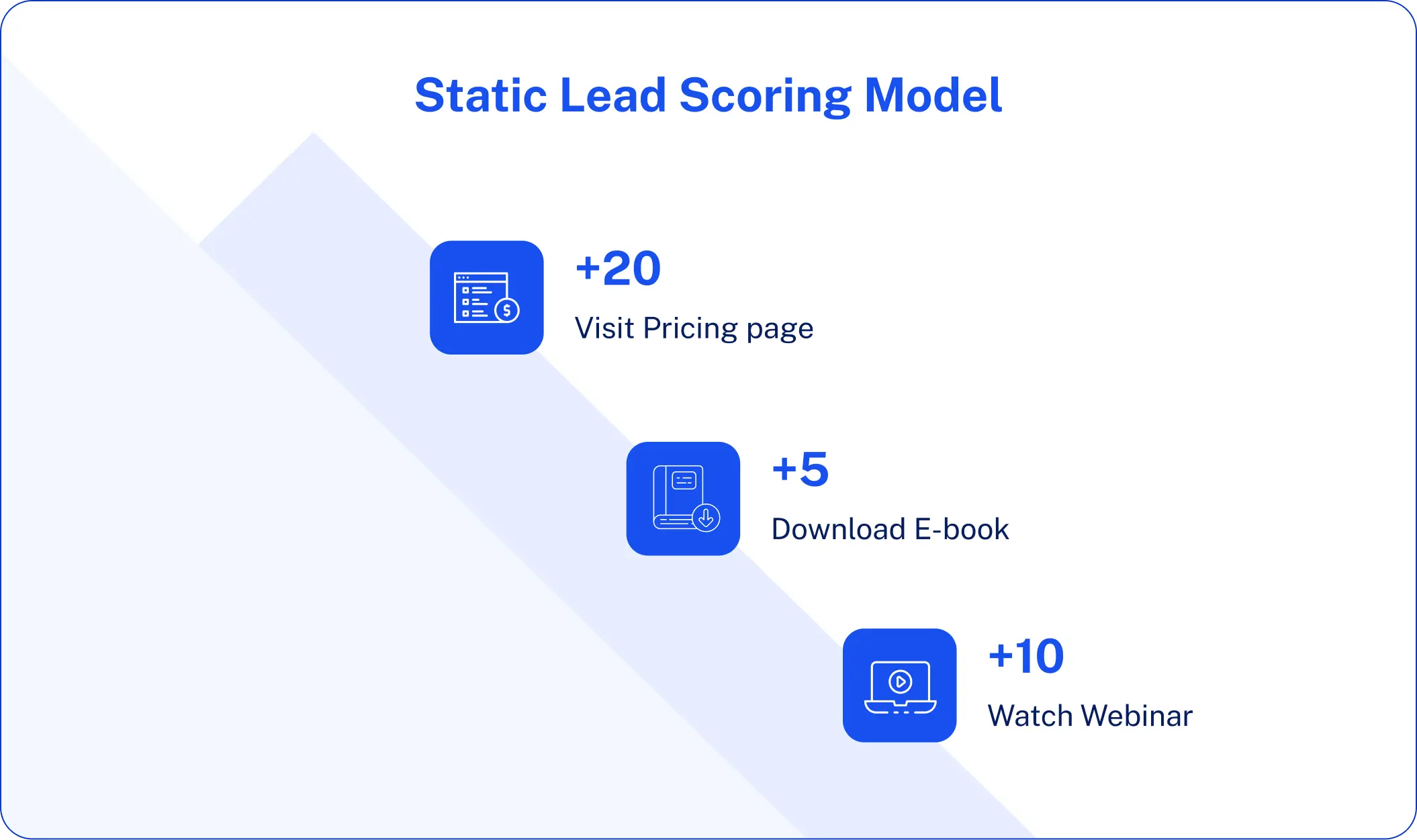
- Lack of Sales and Marketing Alignment
Intent-based marketing requires sales and marketing alignment. Without it, the best that AI can offer in terms of insights will either go unused or be interpreted incorrectly. One of the most prevalent mistakes is failing to define a shared understanding of what defines a high-intent lead and how AI-based lead scores should influence sales activity.
When marketing hands lead to unexpected sales, opportunities are squandered and resources are wasted. Effective organizations establish processes and SLAs for acting upon intent data and maintain open communication between teams.
- Ignoring Feedback Loops
The models improve over time if they are given feedback, but most organizations do not carry out the first step. Without regular input from CRM results and sales teams, AI intent models can’t learn which signals actually correspond to closed deals.
This leads to flat or incorrect scoring in the long term. Closing the loop means continuously providing the AI system with sales outcome feedback, conversion rates, and qualitative information. This allows the model to train making more precise predictions, increasing accuracy and driving better marketing and sales results.
See The Future of AI-Driven Intent-Based Marketing With AI Ark
As artificial intelligence continues to transform intent-based marketing, B2B businesses possess a powerful chance to set the pace. Ability to process intent signals at scale, predict buying behavior, and personalize engagement will more and more determine which companies succeed in building high-quality pipelines.
Achieving this potential is the right tools and skills. That is where AI Ark helps.
Whether initiating to introduce intent data to your lead generation process or looking to optimize your existing processes, AI Ark allows you to harness the full potential of AI-driven intent marketing.
The future of lead generation is intelligent, book a demo today and start this future!
